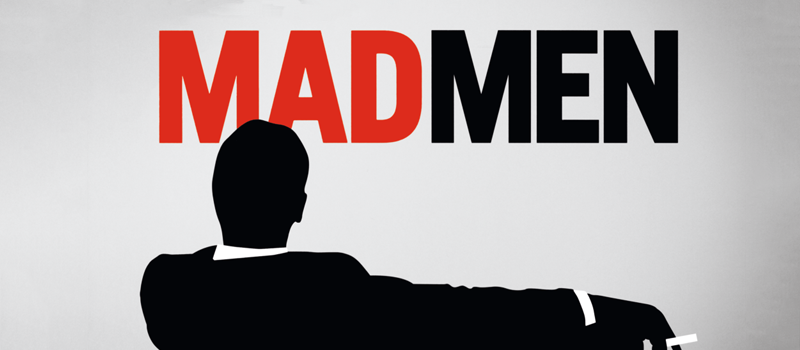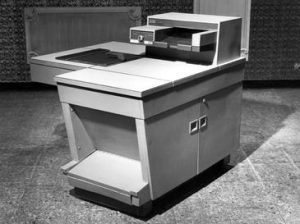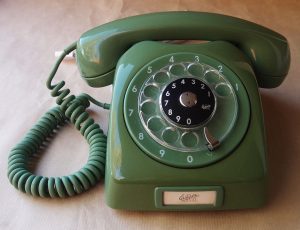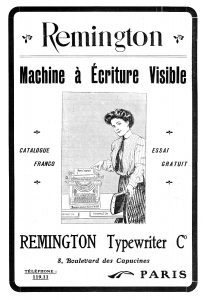
If you are a technology enthusiast amused by current tech transformations, let yourself be enchanted by the excitement of cutting-edge technology from the past. Mad Men, an American television series set in the 1960s and 1970s, narrates the personal and professional experiences of men and women working at a Manhattan advertisement agency, Sterling Cooper. Over the course of seven seasons, Mad Men throws its viewers back to a time when men were making business phone calls using rotary dial phones in their fancy offices, and the fingers of female secretaries were dancing on Remington typewriters “made simple enough for a woman to use,” while Xerox copy machines were never resting.1 This blog post is a journey through some core technologies, as represented in Mad Men, to illustrate the influence of social structures on technological development. The reciprocal relationship between technological and social change is glorified, illustrating how technological development is not an autonomous process, but how it’s shaped by social and cultural factors.

Source: Xerox 914, Wikipedia (Fair use)
The social construction of technology: not only about material things, but also individuals
The commercialization of the Xerox office copy machine 914 revolutionized the document-copying industry.2 By simply putting a piece of paper on a glass and pressing a button, Xerox 914 was able to produce seven copies every minute.3 Very impressive (for that time)! No one saw this coming, not even Sterling Cooper’s creative director, Donald Draper, who rejected the idea that “some magical machine that makes identical copies of things” could exist.4 While many of us are old enough to have used (and are still using) copy machines, 21st century young technophiles may giggle in front of such vintage tool or even look at it confused. We live in a world of 3D printing, where almost anything can be manufactured with a copy machine, even firearms.5 And by the way, who prints paper copies anymore? It is quite charming to realize that an artifact, like the copy machine, loses its meaning if deprived of its historical and social context.6 Once considered a magical machine, the office copy machine becomes a bizarre object to look at for today’s teens who have not acquired the skills to use it. “Technologies are not just objects but also the skills needed to use them.”7

Source: Ericsson Dialog Telephone in green, Wikipedia (Creative Commons Attribution-Share Alike 3.0)
Similarly, it is hilarious (and it also makes me feel old) to see how youngsters miserably fail to make a phone call using a rotary dial phone, another top Mad Men tech gadget.8 In the late 1960s, due to the rotary dial phone, users could initiate a call autonomously, without asking a switchboard operator to place the call for them.9 Before automated, user-controlled phone calls, switchboard operators were essential for the smooth functioning of the telecommunication system. Interestingly, such occupation was considered almost exclusively a female job.10 If you’ve started to feel nostalgic, but cannot remember where you stored your old rotary phone, please do not panic. You can download a rotary dialer app for your smartphone,11 or buy a brand-new rotary phone at a very reasonable price on Ebay.12
Human decisions shape technology development: the QWERTY keyboard
On Ebay, you can also buy a vintage Remington typewriter.13 The history of the typewriter allows us to discuss the unresolved case14 of the QWERTY keyboard arrangement. The QWERTY keyboard was introduced to tackle a technical issue of early typewriters. Initially, letters were positioned on keyboards in alphabetical order. Due to their position, some of the most common letters were located next to each other. When these letters were pressed fast enough, one after the other, the typewriter would get stuck. Therefore, the QWERTY arrangement was introduced to slow people down in their typing, by making sure the popular letters were located far enough apart.15
Interestingly, notwithstanding the progress made by typewriter engineering and the emergence of more efficient keyboard arrangements, QWERTY has remained the most commonly used keyboard arrangement, 16 not everywhere though. In fact, the French created their own keyboard layout, called AZERTY, which is slightly different from QWERTY. Although the AZERTY arrangement seems to be contributing to bad writing,17 France does not want to give up on its “epic keyboard fail,”18 even after it became a government concern. Some people argue that the predominance of the counter intuitive QWERTY arrangement results from people thinking it’s not worthwhile to learn a new keyboard system. Others believe that a cartel of typewriter producers made QWERTY the de facto industrial standard, standing in the way of innovation. Regardless of why the supposedly inefficient QWERTY keyboard survived over 100 years of history, it’s remarkable to see how human choices, whether political, business related or otherwise, shape technology development.19
Gendered technologies: gender fundamental to understand technology (and vice versa)
If your friends are die-hard promoters of gender equality, but you are still struggling with what the word feminism really means, watch Mad Men and overshadow your embarrassment. I know, you might think: “What the heck! We are talking about technology, here!” Well, Mad Men shows how technological and social change goes hand in hand.20 In particular, Mad Men is an unkind portrayal of women’s uphill struggle to their liberation, where technologies become representations of their victories.21
You may not agree with everything she does, but I am sure you will love “bad-ass feminist”22 Peggy Olson, a staple character. She ascends the corporate ladder from being a naïve secretary to achieving her own corner office. That corner office represents the triumph of an ambitious and strong-willed woman in a male-dominated business environment. It may be a bit of a stretch to call an office a technology. But what does technology really mean? As suggested by Karl Marx, in broad terms, the word technology indicates the modes whereby human beings organize their lives, construct their material world, interact with nature, and establish social relations, all based on their conceptualization of the world.23 For Peggy Olson, the corner office was about power. Power which, in the 1960s and 1970s, was predominantly male. Conquering her corner office is a violation of the historical understanding of what is male and female. The association between technology and gender is a human construction, which is why it can change and evolve over time (thankfully!).24
Peggy Olson is also an unmarried woman who takes the birth control pill, “the emblem of changing social mores for unmarried middle-class women.”25 To be precise, doctors could legally prescribe the birth control pill only to married women in the 1960s. Access to the birth control pill for unmarried women came only in 1972.26 Despite this historical imprecision, Peggy Olson is, in my opinion, the most interesting character. She rejects the traditional sex roles of men and women of the time and refuses to be treated differently by her peers, merely because of her gender. Besides, she wears trousers! Although educated women had already started wearing trousers as a form of empowerment, in the late 19th century,27 it was only in the 1980s that it became “normal” for women to wear trousers in the workplace.28
Unintended consequences of technology: the more complex the technology, the lower our capability to foresee its consequences
Above all, Mad Men gives its viewers a glimpse of the ‘golden age’ of advertising, as many widely hailed. In the 1960s, advertising campaign pitches were presented on poster boards and TV commercials were on the rise.29 In today’s society the creativity and intuition of Donald Draper and his team have been replaced by big data. As the popular slogan “from Mad Men to Math Men”30 suggests, advertising in the digital era is the realm of data analysts, algorithms, artificial intelligence and personal advertising. Enormous amounts of Internet and sensor data are continuously stored, updated and analyzed to better understand people’s preferences, to know more deeply the world we live in, and to make evidence-based decisions.31

Source: Cambridge Analytica protest, Wikipedia (Creative Commons Attribution-Share Alike 4.0 International)
Technology has become so complex it’s impossible to foresee all the possible consequences; the risk of failure is great.32 Sadly, our society may have already started paying the costs for utilizing big data. Privacy breaches, national security threats and political instability are just some of the unintended consequences of big data. There are strong assumptions that the public opinion can be substantially altered by using big data.33 You may have heard of about the Cambridge Analytica scandal, where the British consulting company was accused of illegally obtaining and using data of tens of millions of Facebook users, influencing voters’ opinions, contributing to the results of the Brexit referendum, in addition to the 2016 American presidential election. Looking toward the future, I cannot agree more with Nye’s assertion that advanced technologies can improve our lives, however concurrently, they expose us to new dangers.34 Big data collectors and analysts know what we eat, how we dress, where we go, which music we listen to. They know our present to predict our future.35 Have we sold our souls to the devil? Before we ban technological innovation, we should consider that unforeseen consequences may also be desirable.36 The new tech age will hopefully bring beneficial and constructive changes.
Maria Massaro earned a bachelor’s degree in Economics and Management, in July 2011, and a master’s degree in Law and Economics, in November 2013, from Luiss Guido Carli University (Italy), both with honours (110/110 cum laude). She has obtained several prizes for outstanding papers, such as the Yale M. Braunstein Award at PTC’17, the Young Scholar Program at PTC’18, and the third prize for Outstanding Paper at ITS Seoul 2018.
[1]Buck, Stephanie. 2012. Mad Mech Tech: 9 devices that changed the 1960s office, https://mashable.com/2012/03/22/mad-men-tech/?europe=true
[2]Xerox. 1999 The story of Xerography, https://www.xerox.com/downloads/usa/en/s/Storyofxerography.pdf.
[3]Wikipedia, Xerox 914, https://en.wikipedia.org/wiki/Xerox_914.
[4]Ameritel Corporation, it’s not like there’s some magic machine that makes identical copies of things, https://www.ameritelcorporation.com/blog/2014/01/its-not-like-theres-some-magic-machine-that-makes-identical-copies-of-things/.
[5]Wikipedia, 3D printed firearms, https://en.wikipedia.org/wiki/3D_printed_firearms.
[6]Nina E. Lerman, Ruth Oldenziel & Arwen Mohun, “Introduction: Interrogating Boundaries,” in Gender and Technology: A Reader, ed. Nina E. Lerman, Ruth Oldenziel & Arwen Mohun (Baltimore: Johns Hopkins University Press, 2003), 1–9.
[7]David E. Nye. 2006. “Can We Define ‘Technology?,” in Technology Matters: Questions to Live With, Cambridge, Mass.: MIT Press, 1–15.
[8]For instance, Mail Online, Father films comical moment teenage kids try to operate rotary phone and fail miserably, July 2018, https://www.dailymail.co.uk/news/article-5993907/Comical-moment-teens-try-operate-rotary-phone-fail-miserably.html.
[9]Wikipedia, Switchboard operator, https://en.wikipedia.org/wiki/Switchboard_operator; Techwalla, History of the Rotary phone, https://www.techwalla.com/articles/history-of-the-rotary-phone.
[10]Engineering and Technology History Wiki, Telephone Operators, https://ethw.org/Telephone_Operators.
[11]App Store, Rotary Dialer app for iphone, https://itunes.apple.com/us/app/rotary-dialer/id284926166?mt=8.
[12]Ebay, rotary phones, https://www.ebay.com/bhp/rotary-phone.
[13]Ebay, Remingotn Typewriters, https://www.ebay.com/bhp/remington-typewriter.
[14]The Economist. 1999. The QWERTY myth, https://www.economist.com/finance-and-economics/1999/04/01/the-qwerty-myth; Smithsonian.com. 2013. Fact or fiction? The Legend of the QWERTY keyboard, https://www.smithsonianmag.com/arts-culture/fact-of-fiction-the-legend-of-the-qwerty-keyboard-49863249/.
[15]David, A. Paul. 1985. Clio and the Economics of QWERTY, The American Economic Review, Vol. 75, No.2, https://www.jstor.org/stable/pdf/1805621.pdf?refreqid=excelsior%3A18778db19dfe78562b558b8f70ccf5ea.
[16]Ibid.
[17]Délégation générale à la langue française et aux langues de France. 2016. Vers une norme française pour les claviers informatiques, http://www.culture.gouv.fr/Thematiques/Langue-francaise-et-langues-de-France/Politiques-de-la-langue/Langues-et-numerique/Les-technologies-de-la-langue-et-la-normalisation/Vers-une-norme-francaise-pour-les-claviers-informatiques.
[18]Frances Marcellin. 2016. France’s epic keyboard fail: End of the line for AZERTY?, Vive la tech, https://www.zdnet.com/article/frances-epic-keyboard-fail-end-of-the-line-for-azerty/.
[19]Nina E. Lerman, Ruth Oldenziel & Arwen Mohun, “Introduction: Interrogating Boundaries,” in Gender and Technology: A Reader, ed. Nina E. Lerman, Ruth Oldenziel & Arwen Mohun (Baltimore: Johns Hopkins University Press, 2003), 1–9.
[20]Ibid.
[21]Francesca Bray. 2007. “Gender and Technology,” Annual Review of Anthropology 3:37–53.
[22]Erum Jaffery. 2015. 5 ways Peggy Olson is a badass feminist, The Tempest, https://thetempest.co/2015/06/29/entertainment/5-ways-peggy-olson-is-a-badass-feminist/.
[23]Leo Marx. 2010. “Technology: The Emergence of a Hazardous Concept,” Technology and Culture, The Johns Hopkins University Press, 51: 3: 561–577, DOI: 10.1353/tech.2010.0009.
[24]David Harvey. 2003. “The Fetish of Technology: Causes and Consequences,”Macalester International: Vol. 13, Article 7.Available at: http://digitalcommons.macalester.edu/macintl/vol13/iss1/7.
[25]Nina E. Lerman, Ruth Oldenziel & Arwen Mohun, “Introduction: Interrogating Boundaries,” in Gender and Technology: A Reader, ed. Nina E. Lerman, Ruth Oldenziel & Arwen Mohun (Baltimore: Johns Hopkins University Press, 2003), 1–9.
[26]Michelle Gadd. 2016. Birth Control in the 60s, Stay at home mum, https://www.stayathomemum.com.au/my-kids/conception-and-fertility/birth-control-in-the-60s/.
[27]Lindzi Scharf. 2013. Peggy’s ‘Mad Men’ pantsuit: The inside story, Entertainment Weekly, https://ew.com/article/2013/06/24/peggy-mad-men-pantsuit/.
[28]Emma Clark. 2003. Dressing for success, BBC news, http://news.bbc.co.uk/2/hi/business/2815859.stm.
[29]Emily Steel. 2015, ‘Mad Men’ and the Era that Changed Advertising, The New York Times, https://www.nytimes.com/2015/04/04/business/media/mad-men-and-the-era-that-changed-advertising.html.
[30]Thierry Viale, Yves Gendron, Roy Suddaby, (2017) “From “mad men” to “math men”: The rise of expertise in digital measurement and the shaping of online consumer freedom”, Accounting, Auditing & Accountability Journal, Vol. 30 Issue: 2, pp.270-305, https://doi.org/10.1108/AAAJ-12-2014-1887.
[31]Steve Lohr. 2012. The age of big data, The New York Times, https://www.nytimes.com/2012/02/12/sunday-review/big-datas-impact-in-the-world.html.
[32]David E. Nye, “More Security, or Escalating Dangers?,” Technology Matters: Questions to Live With, Cambridge, Mass.: MIT Press, 161–184; M. R. Wigan and R. Clarke, “Big Data’s Big Unintended Consequences,” in Computer, vol. 46, no. 6, pp. 46-53, June 2013.doi: 10.1109/MC.2013.195.
[33]Web Summit 2017, Mad Men to Math Men, https://www.youtube.com/watch?v=L6PWrsr-44E.
[34]David E. Nye, “More Security, or Escalating Dangers?,” Technology Matters: Questions to Live With, Cambridge, Mass.: MIT Press, 161–184.
[35]Kashmir Hill. 2012. How Target Figured Out A Teen Girl Was Pregnant Before Her Father Did, Forbes, https://www.forbes.com/sites/kashmirhill/2012/02/16/how-target-figured-out-a-teen-girl-was-pregnant-before-her-father-did/#57006a646668.
[36]Robert K. Merton. 1936. “The Unanticipated Consequences of Purposive Social Action,” American Sociological Review 1, no. 6: 894–904.










